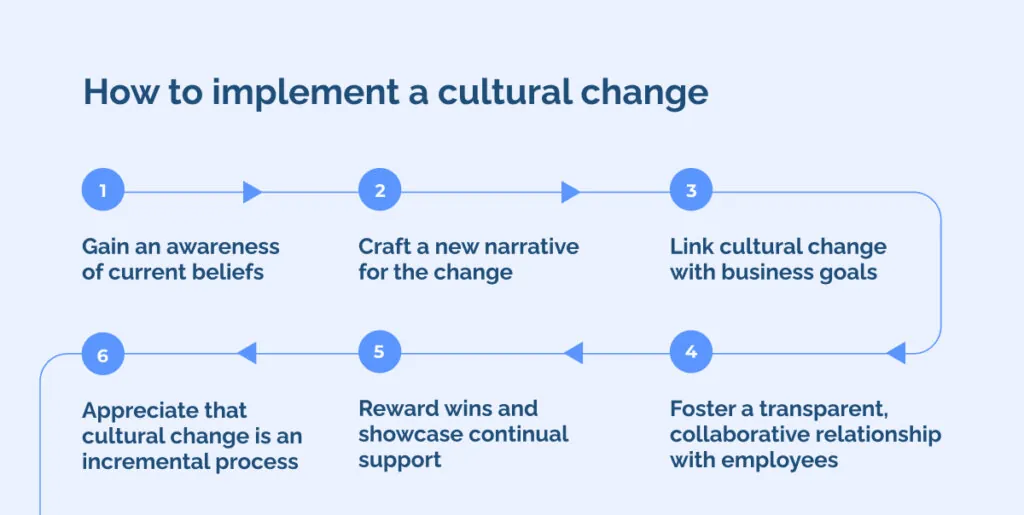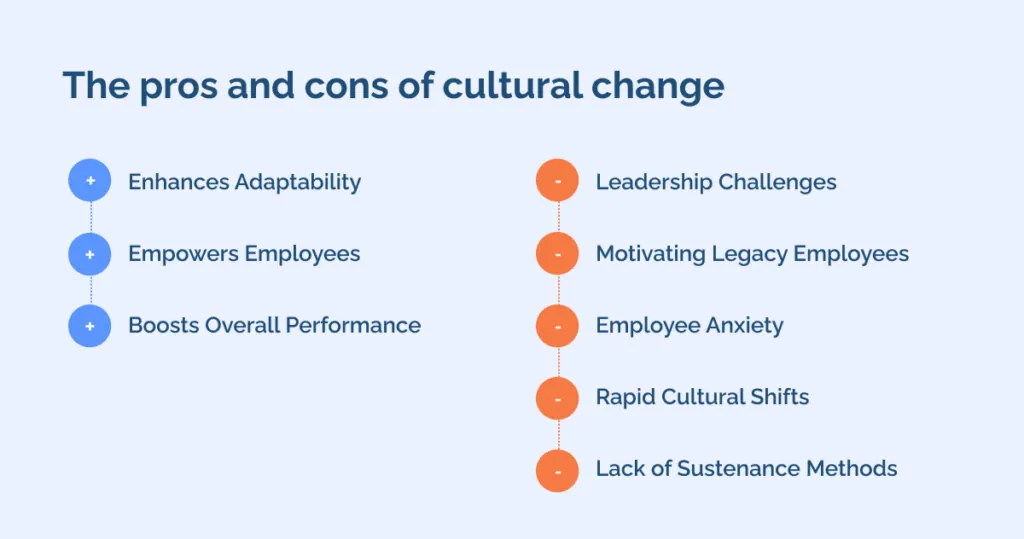
Staying competitive in today’s global marketplace necessitates organizational change and hinges on establishing a culture of trust.
This involves fostering a sense of accountability and responsibility through positive reinforcement and developing a structure conducive to change.
Understanding and implementing these elements can lead to a culture where employees feel empowered to initiate actions, with leadership providing the necessary support.
The importance of engaging employees in a business transformation journey is paramount. Successful change relies on culture, an often invisible force that allows changes to be naturally embedded within the organization.
Building a culture that meets world-class standards demands executive commitment, alignment, and active involvement at all levels.
Research, including studies by Gallup, highlights the crucial link between employees’ comprehension of their company’s mission and the business’s overall health.
In the U.S., for example, about 40% of employees strongly agree that their business’s mission or purpose significantly contributes to their feeling that their job matters. In such an environment, companies are better equipped to swiftly adapt to market fluctuations while focusing on sustained long-term growth.
This article will explore cultural change, including its definition, purpose, and elements. It will assess the pros and cons of such shifts and offer practical strategies for implementation within organizations. Lastly, drawing from successful case studies will illustrate the transformative potential of cultural change in businesses.
What is a cultural change?
Cultural change involves guiding employees toward embracing behaviors that align with the organization’s core values and objectives. This change is often crucial for ensuring employee actions align with present and future business goals.
Implementing successful cultural change is typically a gradual process, emphasizing sustainability to allow employees sufficient time to adapt and integrate the changes without feeling overwhelmed or disconnected.
What is the purpose of a cultural change?
The objective of cultural change within an organization varies, but its primary aim is to improve the work environment. Central to this is the desire to enhance performance and return on investment.
A positive culture attracts and retains customers, turning them into brand advocates and drawing and motivating high-performing employees.
Employees who resonate with their organization’s culture are typically more engaged, leading to higher retention rates than competitors.
Additionally, cultural change serves to navigate an organization through crises, which events like mergers, acquisitions, new leadership, technological advancements, or societal shifts can trigger. For instance, many companies’ recent emphasis on diversity, equity, inclusion, and belonging responds to employee and societal demands.
What are the components required for cultural change?
As organizations embark on cultural change, it’s essential to follow a structured approach that includes foundational elements, collective ownership, and active participation at every stage of the transformation journey.
Let’s explore further:
Foundational Components of Cultural Change:
Cultural change begins with key foundational elements that set the stage for transformation:
- Collaboration: Encourage teamwork and synergy by fostering a collaborative environment where diverse perspectives converge towards common goals.
- Communication: Ensure clarity, transparency, and alignment of efforts through effective communication channels and practices.
- Capacity Building: Invest in nurturing the potential of individuals to enhance overall organizational capabilities, empowering members to contribute meaningfully.
- Community-Driven Approach: Embrace a community-driven ethos, emphasizing collective involvement and shared responsibility to ensure inclusive and diverse voices.
Collective Endeavor and Co-Ownership:
Cultural change is a collaborative effort initiated and sustained by all stakeholders involved:
- Beyond Acceptance: Move beyond mere acceptance or buy-in; cultural change requires active engagement and co-creation.
- Co-Ownership: Foster a sense of ownership among community members, where everyone actively shapes the desired transformation.
- Shared Responsibility: Emphasize shared responsibility, encouraging individuals to contribute their skills and insights towards achieving common objectives.
Active Participation and Involvement:
Genuine cultural change occurs when community members transition from passive participants to active agents of change:
- Commitment to Participation: Cultivate a commitment to active involvement throughout the transformation process.
- Engagement at Every Level: Encourage individuals to engage actively in all facets of the change journey, from planning to implementation.
- Catalysts for Change: Empower individuals to be catalysts for change, driving initiatives and fostering a culture of continuous improvement.
How to implement a cultural change

Transforming a business fundamentally involves altering the culture – its people’s collective mindset and natural inclinations.
So, while this is not an easy process, here are some ways that you can implement a culture change within your business:
Gain an awareness of current beliefs
This complex process begins with identifying and understanding the current cultural beliefs. Leaders should observe and reflect on the outcomes within the organization, identifying desirable and undesirable aspects.
They should then trace these outcomes back to specific behaviors and underlying beliefs.
Acknowledging that these beliefs, while possibly outdated, may have had valid origins is crucial.
For instance, if a business has recently received many complaints that had no basis, employees might be tempted not to take complaints seriously. This belief would need to be changed if organizations were looking to create a better culture around customer service if it was valid based on data.
Craft a new narrative for the change
The next step is reshaping the narratives that drive these beliefs. It involves crafting stories that acknowledge the value of existing beliefs while highlighting their limitations in specific contexts.
Detailed articulation of the desired beliefs, behaviors, and outcomes is essential. Merely explaining the need for change is insufficient; it requires creating a compelling sense of purpose and urgency that resonates deeply with employees.
Link cultural change with business goals
Culture change is not a standalone process; it should be interwoven with enterprise transformation. Embedding culture within the context of business strategy is crucial—it should be a core part of the transformation journey, from initial assessment to evaluating employee performance metrics.
Connecting behavioral changes to business-oriented key performance indicators (KPIs) provides relevant and actionable insights for ongoing improvement.
Consider the analogy of wanting to meditate daily. How would you track your progress in this endeavor? It’s not just about monitoring your daily efforts but also about measuring consistency over time.
Similarly, it’s essential to assess immediate behavioral changes and their sustained application in organizational culture change, aligning them with long-term business goals for a comprehensive understanding of progress.
Foster a transparent, collaborative relationship with employees
Transparency, authenticity, and empathy from leadership are critical. Leaders should communicate regularly, understand employees’ feelings, and proactively address concerns. The new cultural values should be embodied in the leader’s actions and words, as any discrepancy will be perceived as insincerity.
For instance, if a leader wants to promote itself as a business that sees failure as an opportunity to improve, it should not penalize employees who fail. Instead, they should try to learn from any failure agilely.
Leaders must also create a participative environment where employees can understand the reasons for change and contribute ideas. Open dialogues and an employee feedback loop, such as surveys or focus groups, are crucial to creating buy-in and addressing concerns. Including employees in the transformation process is vital as they are the fabric of the company’s culture.
While understanding the broader business context is crucial for culture change, employees must also grasp the more immediate, day-to-day implications — specifically, how their individual work and team dynamics must evolve. Focusing on a select few key behaviors is beneficial to avoid overwhelming employees. Concentrating on these targeted changes simplifies the process and enables the measurement of tangible outcomes.
Reward wins and showcase continual support
Encouraging early adoption among employees, celebrating successes, and acknowledging failures are essential. Leaders should set key performance indicators (KPIs) to measure progress and adjust strategies.
If a team or individual exceeds their goals, they should be rewarded, and this win should be celebrated in the broader organization.
Organizations can implement structured reinforcement mechanisms to foster innovation across different business units, tailoring them to suit each unit’s unique priorities. One approach could be to organize an annual innovation event, with each business unit adapting it to its specific context.
Regular employee feedback loops and continuous support are essential for sustaining momentum.
Appreciate that cultural change is an incremental process
For any change initiative, starting with a well-defined plan is essential. However, it’s equally important to anticipate and be prepared for adjustments to this plan. Cultural change within an organization is a lengthy process, often spanning one to three years. This requires a blend of patience and perseverance.
Initiating change gradually can facilitate a more seamless transition. Inclusive involvement across the organization, from the leadership to the newest employees, is critical to achieving a fully integrated cultural shift.
Regular monitoring and fine-tuning of the process help ensure that the change is consistent with the organization’s strategic goals and remains effective over the long term.
Practical examples of cultural change
Transforming an organization’s culture takes time and effort. It evolves through consistent behaviors over extended periods. For those not in leadership positions, initiating discussions on cultural change can take time and effort.
However, there are inspiring examples from various companies that have successfully driven cultural changes:
MongoDB
This database product platform embarked on a journey to foster a positive security culture. They revamped their security champions program to include over 100 members from 45 global locations. The program hosted numerous events focused on collaborative and educational activities, ranging from capture-the-flag exercises to cybersecurity-themed movie nights.
The diversity in participants’ expertise, from seasoned cybersecurity experts to beginners, enriched the program. They balanced technical sessions like password-cracking with discussions on security playbook for different expertise levels.
The program’s success hinged on keeping it dynamic and engaging, with incentives like tickets to major cybersecurity conferences and regular meetings for feedback and improvement.
SEB
This Nordic corporate bank took a skills-based approach to cultural change. They focused on enabling a small team to apply new skills to significant business challenges. This hands-on method helped link new skills to successful outcomes, altering team members’ assumptions. The key was to start with a culture champion – a leader who believed investing time in skill development would yield positive results.
The process involved intensive, targeted interventions where team members saw the benefits of new skills on real-world problems. This approach created a ripple effect, encouraging the team to advocate for these new skills across the organization. Even skeptics became supporters after witnessing tangible progress.
For instance, an initially doubtful team member became an advocate after applying the skills to a longstanding strategic issue. Another, initially hesitant to promote “soft” concepts like psychological safety, became a vocal supporter after seeing their effectiveness in addressing complex challenges. The team’s offsite meeting was a turning point, where they tackled significant organizational challenges using structured dialogue and new skills, leading to practical outcomes and reinforcing the value of these skills.
Wipro
In 2020, Wipro, a prominent Indian software company with over 220,000 employees worldwide, embarked on a significant cultural transformation. The initiative was led by Rishad Premji, who became the executive chairman in July 2019.
He recognized that despite the company’s solid foundation in strategy, people, investments, and purpose, Wipro’s performance was not meeting its potential. He aimed to transform Wipro into a high-performing yet soulful organization characterized by empathy, vulnerability, collaboration, and decency.
Premji’s approach involved deep introspection and understanding of the company’s challenges. He identified issues in collaboration, organizational silos, trust, and willingness to work across different departments as crucial obstacles.
To address these, he initiated a series of one-on-one conversations and formed four task forces focusing on collaboration, non-negotiable behaviors, stewardship, and metrics. These teams engaged extensively within the company, with alumni and even customers, to identify areas for improvement.
The transformation strategy emphasized behavior change, focusing on simple, universally applicable habits. These habits included being respectful, responsive, communicative, demonstrating stewardship, and building trust. The aim was to ensure these behaviors were understandable and relatable across diverse cultures and locations.
Premji personally led the change, conducting 89 sessions over 300 hours and interacting with 28,000 employees worldwide. He prioritized storytelling over formal presentations to connect with the workforce. Additionally, Wipro strengthened its rewards and recognition system to reinforce positive behaviors, focusing on monetary and nonmonetary acknowledgments.
This comprehensive approach aimed to foster a culture of trust, responsiveness, and stewardship, adapting to the challenges of a diverse and rapidly growing organization. Premji’s hands-on leadership and focus on relatable, simple habits were vital in driving this cultural shift at Wipro.
Tibber
At Tibber, a Swedish energy company, the essence of culture is deeply rooted in shared values. This approach emphasizes identifying, articulating, and consistently living these values rather than just displaying them as slogans. For Tibber, leadership must exemplify the desired behaviors and culture to maintain coherence, especially during recruitment.
The company has crafted an organizational culture that prioritizes employee growth and satisfaction. This is achieved by understanding what motivates their workforce, which they break down into three key components: purpose, mastery, and autonomy.
Autonomy forms the cornerstone of Tibber’s organizational structure. They have adopted a model where small, autonomous groups, called ‘squads,’ operate like mini-startups within the company. These squads can make independent decisions but can access the company’s full support and resources.
This autonomy is vital for employee retention and overall job satisfaction, allowing employees to own their work and decision-making processes.
Mastery is another focal point for Tibber. The company actively encourages skill development through initiatives like the ‘hot seat’ system. This system enables employees to temporarily join different teams, exposing them to new technologies, challenges, and learning opportunities. Such experiences enhance their expertise and keep them engaged and motivated.
In essence, Tibber’s approach to culture is about creating an environment where employees can excel. By giving them the freedom to make decisions and the opportunity to learn and grow constantly, Tibber fosters a dynamic and fulfilling workplace.
The pros and cons of cultural change

Organizations that are primed for cultural change enjoy numerous advantages over those that are not.
These are:
- Enhances Adaptability: Boosting a company’s capacity for rapid adaptation is essential for staying competitive in an ever-changing market.
- Empowers Employees: Encouraging employee input in decision-making fosters ownership and accountability, strengthens trust and loyalty between employees and employers, and improves workforce dedication and employee retention.
- Boosts Overall Performance: Cultivating cultural change to enhance individual performance can translate into broader business improvements, as collective efforts towards shared objectives often result in enhanced success.
However, implementing cultural change can be difficult if:
- Leadership Challenges: Business leaders need to understand the importance of their role in achieving cultural change to own or champion change effectively.
- Motivating Legacy Employees: Organizations need help encouraging employees who resist changing long-established practices. This resistance often stems from a need for more understanding of the change’s purpose, leading to a reluctance to adapt.
- Employee Anxiety: Ambiguity in the change process can cause anxiety among employees, who may fear their inability to adjust, feel uncertain about their role, question their skill adequacy, and worry about potential increases in workload.
- Rapid Cultural Shifts: Introducing cultural change too abruptly or dramatically, instead of through gradual steps, can be particularly unsettling for employees.
- Lack of Sustenance Methods: The absence of consistent reinforcement mechanisms, such as systems, processes, and regular training, makes embedding a new organizational culture challenging.
Final thoughts on culture change
Cultural transformation is pivotal for sustainable change, with fundamental aspects like effective communication, employee engagement, and leadership unity. The real challenge lies in connecting cultural initiatives to tangible, business-oriented changes that directly influence the behavior of frontline staff.
By integrating the three lessons outlined, companies can foster a collaborative environment where culture experts and business leaders mutually benefit and drive enduring change.
Changing habits is complex and multifaceted, especially in an organizational culture shift. To bring about effective change, it’s critical to treat it as a movement, involving key influencers and allowing ample time for the change to be deeply rooted and grow.
Resistance is a frequent barrier, often rooted in fear. Cultural change can be intimidating, leading to pushback. Addressing these fears with understanding and empathy is crucial.
A thriving cultural shift requires a strategic approach from the outset, encompassing a clear vision, a strategic plan aligned with this vision, and a timeline that supports the gradual adoption of new behaviors and norms.
Central to this strategy is ensuring that team members resonate with the organization’s mission. Showcasing how the change will deepen their connection to the mission and their roles is essential for their support and commitment.
Behavioral change is at the core of cultural transformation, necessitating patience, time, and consistent effort across the organization. Leadership plays an essential role in this journey.
When leaders effectively embody new behaviors, it sets a powerful example, creating a domino effect across the organization. This eases the transition and ensures the longevity and significance of the cultural shift, making it a sustained movement rather than a temporary phase.
WalkMe Team
WalkMe spearheaded the Digital Adoption Platform (DAP) for associations to use the maximum capacity of their advanced resources. Utilizing man-made consciousness, AI, and context-oriented direction, WalkMe adds a powerful UI layer to raise the computerized proficiency, everything being equal.



